Japan Wood Products
Prices
Dollar Exchange Rates of
10th February 2014
Japan Yen 102.27
Reports From Japan
Domestic demand expected to maintain strength
despite tax increase
The Deputy Governor of the Bank of Japan, Kikuo Iwata,
recently presented the Bank‟s view of prospects for the
economy at a meeting with business leaders in Miyazaki
prefecture.
See:
https://www.boj.or.jp/en/announcements/press/koen_2014/
data/ko140206a.pdf
He reiterated the Bank‟s view that aggressive quantitative
easing is the way to support the government‟s efforts to
pull the Japanese economy out of deflation.
He repeated that the aim of the Bank is to achieve a 2
percent year on year increase in the consumer price index
(CPI) and that the Bank will continue with the quantitative
easing as long as necessary to achieve the 2% target. The
Bank of Japan has been steadily increasing the monetary
base, mainly through the purchase of long-term Japanese
government securities.
Looking ahead, the Deputy Governor said “Domestic
demand is likely to maintain firmness and external
demand is expected to increase, albeit moderately”.
Against this backdrop, while the economy will continue to
improve a short term decline can be expected after the
consumption tax increase.
At the monetary policy meeting held last month, the Bank
reviewed its outlook for economic activity and prices
through to the end of fiscal 2015. The median Policy
Board forecasts are for real GDP growth rates to be 2.7%
in fiscal 2013, 1.4% in fiscal 2014, and 1.5% in fiscal
2015.
Efforts to generate inflation are working
Data from Japan‟s Finance Ministry indicates that in
December 2013, inflation accelerated, industrial output
expanded and demand for workers increased which
suggests the current fiscal initiatives of the government are
having a positive effect in the real economy.
Another positive sign was that industrial production rose
in December last year.
The most immediate test of business confidence going
forward into 2014 will come when the annual wage
negotiations are concluded and when the impact of the
April 1 consumption tax increase can be assessed.
If workers cannot secure wage increases then inflation will
eat into family disposable incomes driving down domestic
demand. At the moment Japan's economy is showing
remarkable improvement and a strength not seen for years.
The question is how consumers are going to respond over
the next few months?
Consumer confidence falls
Japan‟s Cabinet Office has released the results of the
January 2014 Consumer Confidence Survey.
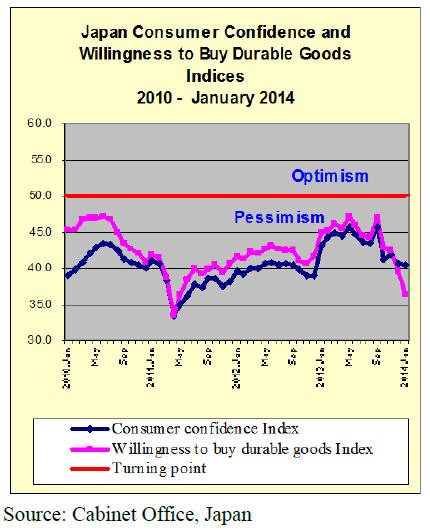
Householder confidence slipped for a second consecutive
month with the consumer index dropping from 40.6in
December to 40.4 in the January survey.
Among the sub-components of the index, the overall
livelihood index fell and the assessment of income growth
potential also fell. The index for consumer willingness to
buy durable goods was down sharply (Dec. 2013, 39.6 to
36.4 in Jan. 2014).
Overall most households surveyed were pessimistic on
three of the four factors assessed: economic well-being,
income growth and purchasing of durable items. Rather
surprisingly, consumers were optimistic on job prospects
an upward trend recorded for three months.
For the complete data see:
http://www.esri.cao.go.jp/en/stat/shouhi/shouhi-e.html
Japan composite index improves
The key indicators of the current state of the Japanese
economy released by the Japanese Cabinet Office all
improved in December and moved to the highest level in
more than five years. Companies have increased output
and are beginning to offer more jobs as they see profits
improve.
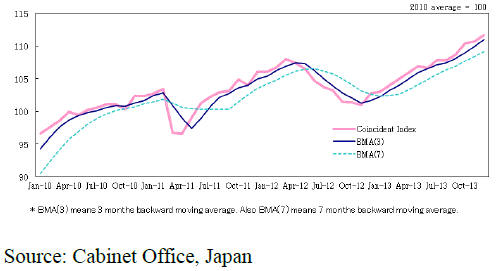
The index of coincident indicators comprising industrial
output, retail sales and new job offers, climbed 1.0 point
from the previous month to 111.7, up for the fourth
straight month (100 = base line 2010). The December
results are the best since 2008, prior to the global financial
collapse.
The index of leading indicators, which offers a window on
developments over the next few months also improved in
December, moving up to 112.1 driven by more confidence
in the private sector.
Impressive growth in housing starts
According to a report released today by the Ministry of
Land, Infrastructure, Transport and Tourism Japan‟s 2013
housing starts were up 11% from 2012 a record pace of
increase not seen since the mid 1990‟s.
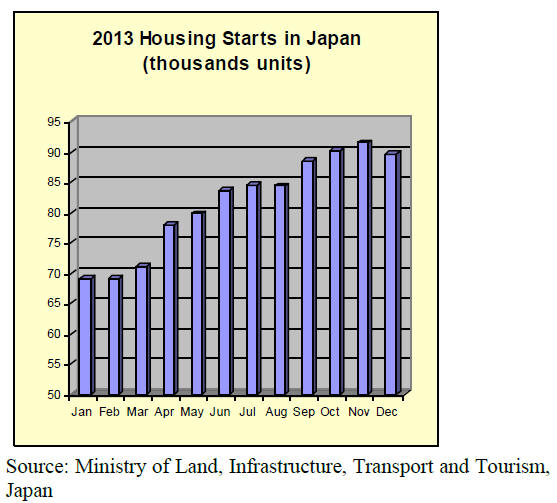
Housing starts in December were 89,600 down from the
91,500 in November but some 18% higher than in
December 2012. The decline in December is the result of
the slow-down in construction because of the weather,
especially in the northern prefectures and because of the
end of year holidays.
Japan‟s housing starts rose for a 16th consecutive month in
December 2013, the longest consistent improvement since
1994.
While consumer optimism is growing much of the
increase in housing starts is in response to the planned
increase in consumption tax due to take effect in April this
year. Analysts expect housing starts to peak in March and
then fall back as the new tax regime comes into effect.
Overall housing starts in Japan in 2013 were 1.06 million
units slightly above earlier forecasts.
Yen exchange rate reacts to emerging economy
difficulties
Forecasts are for the yen to stabilise at around yen 100-
110 to the US dollar throughout 2014 but the mixed
signals from the US Federal Reserve and the instability of
emerging market currencies will tend to strengthen the yen
higher. In mid February 2014 the yen was trading at
around 101 to the dollar.
The economic problems in emerging economies are
undermining the weak yen policy of the Japanese
government and Central Bank. If demand in emerging
markets weakens significantly there will be a direct and
negative impact on Japanese exports.
Around half of Japan‟s exports go to emerging markets
including China (20%) which rises to almost 30% if Hong
Kong and Taiwan P.o.C markets are included. Any decline
in imports from these and other emerging markets would
seriously undermine the efforts of the Japanese
government beat deflation.
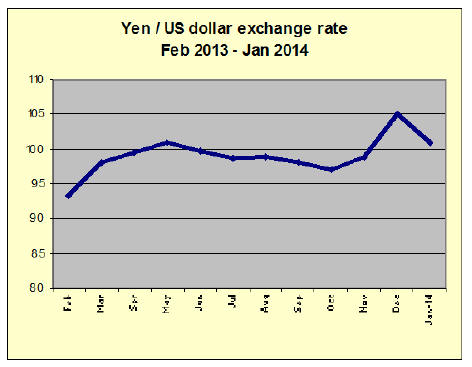
Jetro survey of Japanese firms overseas
Between September 13 and October 23 2013, the Japan
External Trade Organization (JETRO) conducted its latest
survey on the business operations of Japanese-affiliated
firms in the five countries in Africa where JETRO offices
are located (South Africa, Egypt, Kenya, Nigeria and Cote
d'Ivoire.
More than half the Japanese companies surveyed forecast
an upturn in business with Africa and 60% of companies
surveyed expect to expand sales in African markets.
However respondents noted “the business environment in
Africa remains harsh with political and social instability,
employment and infrastructure being the main issues of
concern.
Interestingly most respondents located overseas cited
insufficient understanding by and poor communication
with corporate headquarters as the greatest problem.
For more information please see:
https://www.jetro.go.jp/en/news/announcement/20140206
116-news
Workforce reform- more foreign workers to come
The Japanese government is making it easier for the
private sector to recruit foreign workers for highly-skilled
positions and as trainees a move which, say analysts, will
help offset the shrinking domestic workforce and will
support expansion of the economy.
This move comes on the heels of a decision to encourage
and support expansion of the female workforce. To
encourage qualified and skilled mothers to return to work
the government is strengthening the child care system and
is setting voluntary targets for female worker employment
by companies.
The domestic workforce in Japan is shrinking as the
country has the most rapidly aging society in the world,
with a quarter of the population already over 65.
Expansion of the foreign workforce and getting more
women employed or re-employed is important for easing
labour shortages and increasing tax revenues.
Trade news from the Japan Lumber Reports (JLR)
The Japan Lumber Reports (JLR), a subscription trade
journal published every two weeks in English, is
generously allowing the ITTO Tropical Timber Market
Report to extract and reproduce news on the Japanese
market.
For the JLR report please see:
http://www.nmokuzai.
com/modules/general/index.php?id=7
North American log import in 2013
Total import of North American logs in 2013 was
3,415,440 cbms, 14.4% more than 2012. Demand for
North American logs increased by both lumber and
plywood for busy housing starts.
Also the supply of North American lumber did not cope
with expanding demand in Japan so that the demand
shifted to domestic products. The cost of North American
lumber climbed due to weakening yen.
Lumber shipment by Chugoku Lumber, the largest
Douglas fir lumber manufacturer in Japan in 2013 was
1,440 M cbms, 19% higher than 2012, which verifies
aggressive log demand.
Domestic wood products market in Tokyo region
Market prices of domestic lumber in Tokyo region
continue climbing. All the sawmills are running full to
catch up orders but the demand is expanding much larger
than the supply capacity so the supply shortage seems to
continue for some time.
However, there are some changes by users to shift to
imported products after the prices of domestic lumber
soared so much then log inventories by sawmills are ample
now so that the market feels the prices are peaking and the
concern is how long the market holds high prices.
The prices of KD cedar 120 mm post (special grade)
leaped to 65,000-67,000 yen per cbm, 10,000 yen up from
early December, of KD cypress sill jumped up to 90,000-
95,000 yen, 20,000 yen up, of KD cedar stud climbed to
65,000 yen. The prices are up by about 40% to 50%
compared to last summer.
Wood demand projections from Forestry Agency
The Forestry Agency held meeting for wood products
demand projection in December last year. It drew up
demand projection for the first quarter and second quarters
of this year. According to this, the first quarter would stay
without much change but the second quarter would drop
related to the end of rush orders in late last year.
Projections of domestic logs for lumber production in the
first quarter are 3,090,000 cbms, 4.1% more than the first
quarter last year then for the second quarter are 3,040,000
cbms, 2.4% less. Logs for plywood for the first quarter are
740,000 cbms, 2.9% more then the second quarter are
750,000 cbms, 5.2% less.
Total for the first quarter is up by 3.9% then for the second
quarter is down by 2.9%.
Imported logs for the 1st quarter are 1,105,000 cbms, 1.2%
down then for the 2nd quarter are 1,095,000 cbms, 14.6%
down. Imported lumber for the 1st quarter is 1,695,000
cbms, 1.4% down then for the 2nd quarter is 1,800,000
cbms, 14.8% down.
Drop of both logs and lumber for the 2nd quarter is larger
than the 1st but this is due to large volume for the 2nd
quarter last year and the volume of logs remain unchanged
from the 1st quarter and lumber volume actually increases
for the 2nd quarter.
As to North American lumber, import of the 1st quarter
would increase by 2.2% because of declining inventories
but the 2nd quarter would drop by 10.6% by declining
demand.
European lumber, which inventory is high, would drop by
7.4% in the 1st quarter and by 21.2% in the 2nd quarter.
Radiata pine logs and lumber would increase as export
cargoes would grow.
Both domestic and imported structural laminated lumber
would increase for the 1st quarter with 535,000 cbms,
7.9% up then drop in the 2nd quarter with 540,000 cbms,
7.9% down.
Domestic plywood would increase for both 1st and 2nd
quarter by 9.0% and 2.3% but the imports would decrease
so total would be 1,570,000 cbms for the 1st quarter (1.1%
down) and 1,590,000 cbms for the 2nd quarter (5.6%
down).
Forecast of the seasonally adjusted annual housing starts
are 997,000 units for the 4th quarter 2013, 925,000 units
for the 1st quarter and 859,000 units for the 2nd quarter.
European lumber market
Market of redwood laminated beam and whitewood post
has been tightening after the inventories of imported
products are dropping by active operations by precutting
plants so that now the orders are coming to domestic
laminated lumber manufacturers. With brisk orders, the
plants are so busy that deliveries take more than a month.
The manufacturers are aggressively seeking to increase the
prices but at the same time, they are afraid of demand slow
down after the first quarter.
Radiata pine logs and lumber
Crating lumber market is tightening after Orvis, the largest
radiate pine lumber manufacturer, announced to close its
Himeji mill in April.
Lumber buyers place orders to multiple suppliers so that it
is much larger than actual demand. Also lumber buyers
want to procure before the consumption tax is increased in
April.
Radiata pine sawmills carry order balance for about a
month then competing domestic larch and cedar plants
also have order files of more than two weeks so the supply
is tight.
The market prices are firming after both New Zealand logs
and Chilean lumber export prices are up. New Zealand A
sort log prices for January shipment were $5 per cbm C&F
up and further increase is likely.
Chilean lumber suppliers proposed higher prices and the
negotiations had tough going but final settlement was $5-
10 up for February shipment.
Plywood
Supply of domestic softwood plywood continues tight.
Orders by precutting plants are brisk as their February
orders are all filled up.
Meantime, plywood manufacturers produced 226,500
cbms in December, 12% more than December last year
despite shorter operating days then the shipment was high
at 226,600 cbms, 7.4% more.
The inventories were 119,000 cbms, 2.3% less than
November, the lowest in 2013.
The market prices are 980-1,000 yen per sheet delivered
on 12 mm 3x6, 20 yen up from November, 1,450 yen on 9
mm 3x10 long panel and 1,950 yen on 24 mm 3x6 thick
panel. Both are flat.
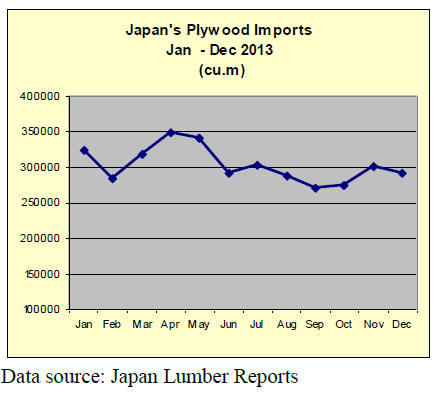
Market of imported plywood continues firm with tight
supply. Both 3x6 JAS concrete forming for coating and 9
and 12 mm structural panel are particularly tight. Future
seems high due to higher export FOB prices by the
suppliers and weakening
yen so that wholesalers are aggressively procuring what‟s
available now.
The prices seem to continue edging up without support by
actual demand. Market prices are hard to pin point as there
is gap between importers‟ asking prices and wholesalers‟
desirable prices. Concrete forming JAS 3x6 panel prices
are 1,250 yen per sheet delivered, 50-70 yen up from
December. 12 mm structural panel prices are 1,320 yen,
70-90 yen up. 3x6 JAS concrete forming panel for coating
is 1,350 yen, 50 yen up.
Price trends for Japanese imports of Indonesian and
Malaysian plywood
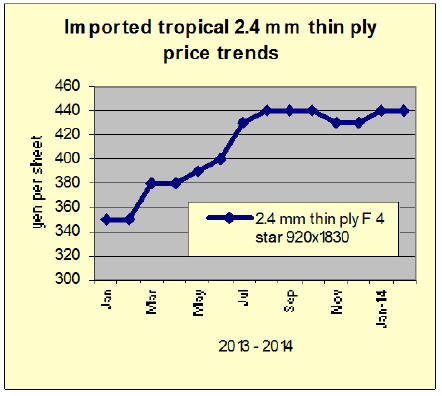
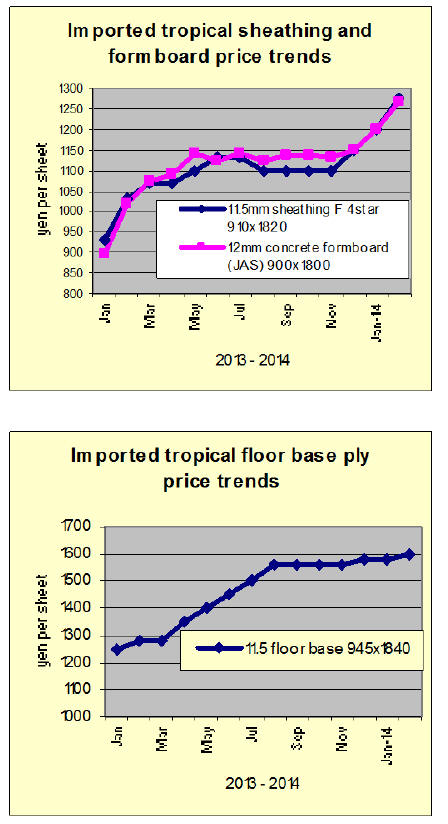
Certified wood for the 202 Olympics
Two major forest certification organizations, FSC, PEFC
and the Japanese own organization, SGEC (Sustainable
Green Ecosystem Council) have started activities to
promote using certified wood for the Olympic Games held
in Tokyo in 2020.
This is the first such joint activities by three corporations.
Three corporations had several meetings since last fall and
came up with the request to use forest certified wood for
athletic and related facilities of the Olympic and submit
the request to administrative organizations.
Vancouver winter Olympic in 2010 was the first Olympic
to use certified wood then in London Olympic games in
2012, for the request to use sustainable wood and paper for
consumption by organizing committee, FSC and PEFC
were selected. Consequently total of 12,500 cubic meters
of wood was used for various facilities and almost 100%
was certified wood.
Trends in office, kitchen and bedroom furniture
imports
Japan‟s office kitchen and bedroom furniture imports from
2009 to the end of 2013 are shown below. Imports of
bedroom furniture exhibit a cyclical trend and between
2009 and 2011 monthly imports followed much the same
pattern but overall annual imports did not increase during
this period. However from 2012 bedroom furniture
imports began to increase and the established cycle
changed as monthly imports tended to level out such that
the difference in value between the highs and lows
narrowed.
2012 bedroom furniture imports averaged yen 1,414 mil.
and were up 12% on 2011 levels while imports in 2013
averaged yen 1,727 mil. and expanded 22% compared to
2012.
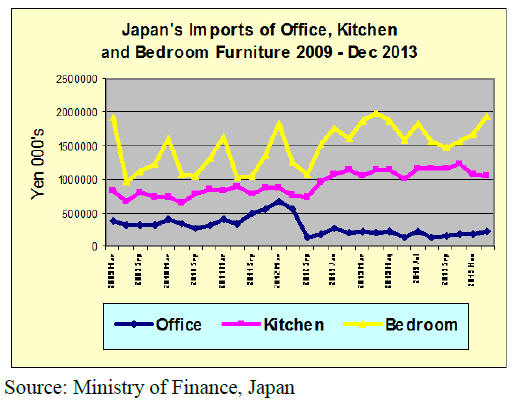
In contrast to the pattern of bedroom furniture imports in
the case of kitchen furniture imports there has been a
steady rise beginning from 2011. 2012 imports of kitchen
furniture were affected by the weak Japanese economy
much more than imports of bedroom furniture and
monthly imports averaged only yen 750 mil in 2010,
expanding to yen 844 mil. in 2011, yen 832 mil. in 2012
and yen 1112 mil. in 2013.
Despite the 2013 improvement in business sentiment in
Japan and greater investment by the private sector imports
of office furniture weakened considerably from levels in
2011 and 2012.
In 2011 office furniture imports were up 46% on 2010 but
from 2012 imports fell steadily. In 2013 average monthly
imports of office furniture were yen 195 mil. compared to
the high of yen 454 mil. in 2011.
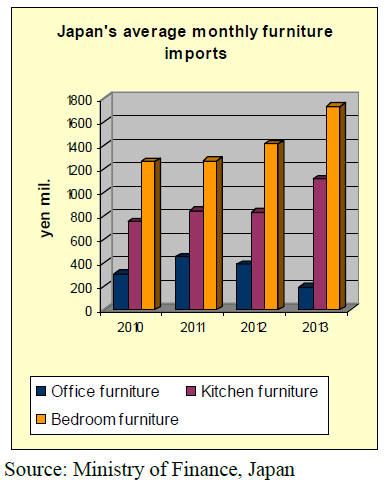
Office furniture imports (HS 9403.30)
In December 2013 Japan‟s imports of office furniture
increased by 23.5% following the 9.5% increase in
November imports. The top supplier remains China which
provided 47.5% of all December imports, marginally
down on the yen 93.3 mil. supplied in November 2013.
The three main suppliers in December, as in previous
months, were China, Poland and Portugal which together
accounted for significantly more of all office furniture
imports in November. Almost all of the increased imports
in December were supplied by these top three suppliers.
For December 2013 Japan‟s imports office furniture from
China were up around 3%, while imports from Poland
almost doubled. Office furniture imports from Malaysia
and Indonesia fell sharply in December as did imports
from Italy.
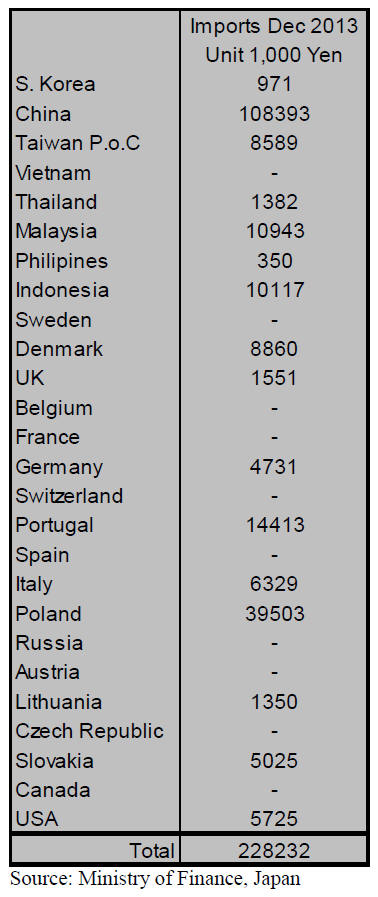
Kitchen furniture imports (HS 9403.40)
In order of value of imports Vietnam, China Indonesia and
Philippines continued to provide the bulk (89%) of kitchen
furniture imported by Japan according to figures from
Japan‟s Ministry of Finance. December 2013 kitchen
furniture imports, at yen 1,040 mil. were down slightly on
November imports. Asian suppliers provided 89% of
Japan‟s kitchen furniture imports in December 2013.
Vietnam maintained its position as the number one
supplier of kitchen furniture by a significant margin
supplying 35% (39% in November 2013) of Japan‟s
kitchen furniture imports.
The other main suppliers were China (21.5%) Indonesia
(17.4%) and Philippines (15%). Imports of Kitchen
furniture from Vietnam in December fell by around 12%
and imports from Indonesia and Philippines also declined.
In contrast, imports from China grew 27%.
Of the non-Asian suppliers Germany replaced Italy as the
number one supplier in December but December imports
were below that in November.
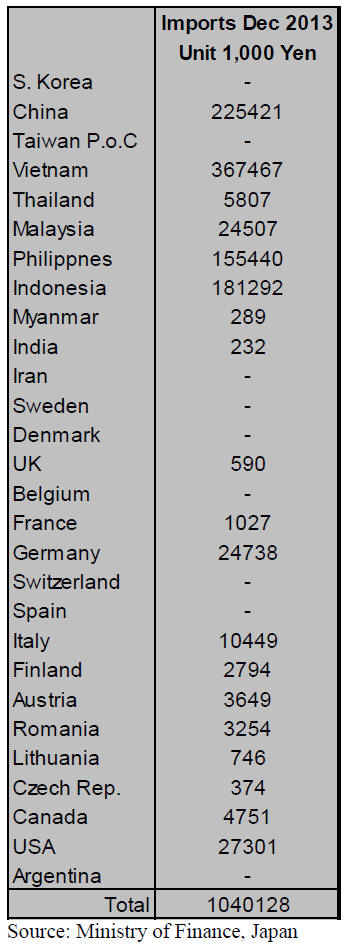
Bedroom furniture (HS 9403.50)
Japan‟s imports of bedroom furniture have steadily
increased throughout 2013 as can be seen from the annual
growth figures illustrated above.
December 2013 imports of bedroom furniture were a
record yen 1,939 mil. up almost 16% on levels in
November. Once again China topped the table of bedroom
furniture suppliers to Japan, providing some 57% of all
bedroom furniture.
Together, China, Vietnam and Malaysia accounted for
most (88%) of all bedroom furniture imports. The rise in
overall imports of this item was largely due to increased
supplies from the top three suppliers.
The other main suppliers were Poland, yen 39.9 mil.;
Indonesia, yen 29.7 mil.; USA, yen 23.7 mil.; followed by
Slovakia and Italy at just over yen 10 mil. each.

|